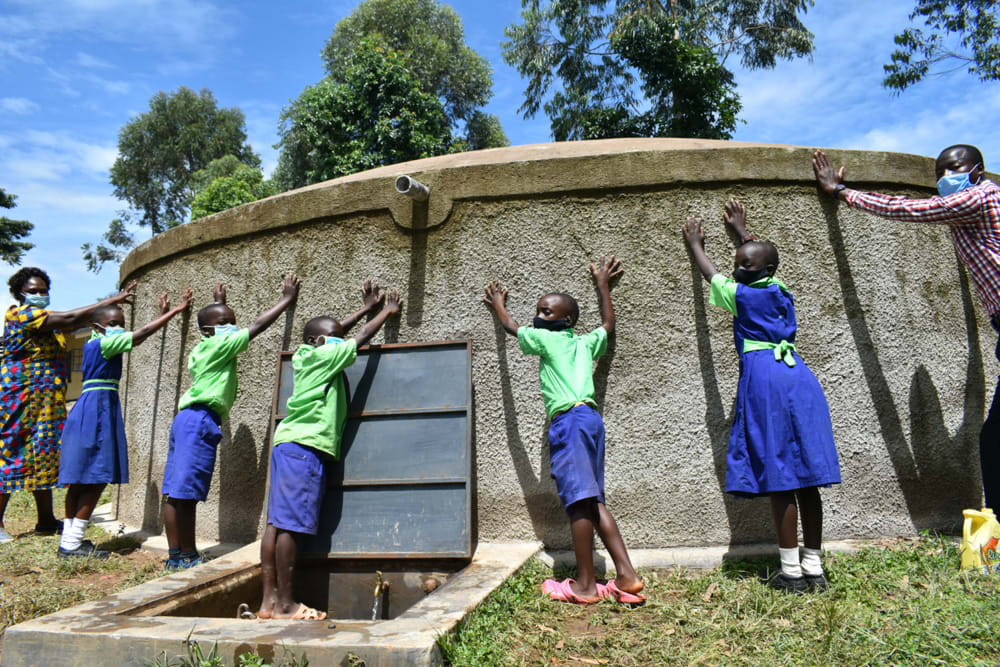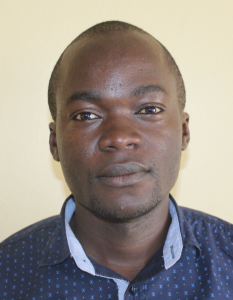December, 2020: Boyani Primary School Project Complete!
We have exciting news!
When Kenya closed schools nationwide in March 2020 to help curb the spread of the novel coronavirus, we worked carefully to ensure Boyani Primary School's rain tank and latrines reached completion despite the closure. To achieve this, we relied on a combination of mutual trust and communication with the school and students' families to finish construction while keeping our team and the community safe.
Kenyan schools were initially scheduled to reopen in January 2021, when we planned to train students and teachers on COVID-19 prevention, handwashing, and how to take care of their new rain tanks and latrines.
However, recently, the Kenyan government allowed certain students to resume their classes for the remainder of 2020. Upon hearing this news, we treated the water in every school rain tank to ensure a fresh supply of drinking water for the returning pupils.

A student enjoys a fresh drink from the rain tank.
Once students returned to school, we acted quickly to offer our health, hygiene, and COVID-19 training to schools to use clean water from their rain tanks to keep students and teachers safe and healthy. Our good relationship and open communication with Boyani Primary School led our principal to invite our team to conduct the training immediately.
While there, we also officially handed over the rain tank and latrines to the school. Though limited in scope, this was a particularly joyous celebration as we had not expected this would be possible until some time next year.

The handing over ceremony marks the students and teachers officially taking ownership of their new rain tank, latrines, and handwashing stations.
"Access to clean and safe water will promote good health and long life, therefore, minimizing frequent visits to the hospital seeking treatment. It also empowers individuals as the little money they have is used to support developments in school and even at home," said student Ephraim.
"Being a pupil at this school, I will have enough time to concentrate on my studies and even the entire school, leading to improved school performance in different activities such as sports, academics, and agriculture."

Teachers were just as excited as the students about the new rain tank on campus.
"Time will be created for me to work on the progress of the school. Students will no longer carry water from home and won't have to be buying it from vendors," said teacher Mr. Libese Benson.
"Access to clean and safe water will provide the school with good working conditions and consumption purposes. It will also help in carrying out manual cleaning, thus improving the standard of hygiene."

Teacher Mr. Libese Benson with a pupil at the rain tank.
"The fact that we can now access clean and safe water - the levels of hygiene will improve in the entire school, and health issues will be minimal compared to the past. School developments will progress effectively, thus promoting good academic performance," he added.

Training
The school and our team agreed that adherence to physical distancing and mask-wearing whenever possible would be necessary to train the students safely. With a strict timetable to minimize exposure and an eager student body ready to learn, we sent facilitators Victor Musemi and Sam Simidi to lead the training.
20 students and teachers attended training, which we held outside the classroom under the shade of trees. The day's weather was good as it was a mixture of sun and clouds, making for a favorable learning environment. We focused on COVID-19 prevention, transmission, and symptoms while also covering several other topics.

Handwashing training session
"As a community, we had already been enlightened about this virus. Handwashing stations were already located around the school gate, and even social distances had already been done with pupils wearing face masks and adhering to COVID-19 measures," said student and Sanitation Prefect Anabell.
"I really appreciate and thank God for keeping us safe from this pandemic which kills people and also adversely affects our economy. On mitigation measures and signs and symptoms of COVID-19, I am now in a better position to create awareness to others, especially older people in society, and even the entire school fraternity."

Handwashing practical
Other topics the facilitators covered included personal hygiene such as bathing, oral hygiene, the ten steps of handwashing; environmental hygiene; child rights; operation and maintenance of the rain tank, latrines, and handwashing stations; and leadership and governance.
"It has been stated that knowledge is power and I thank God for this privilege to acquire this information. I personally have learned a lot from you concerning hygiene and sanitation, child rights, and the better way of maintaining this [rain tank]. Surely I will live to remember and be a good ambassador of the project to other people in society," said Headteacher Mr. Kibet Samoei.

The group celebrates clean hands for all after the handwashing session.
During the governance session, the students elected their peers to lead their newly formed student health club. This session was extraordinary because a young girl from grade four found herself elected into a leadership position. It surprised many students from other classes who were not elected due to their behavior. This really showed that the concept of electing the person with the best skills and behavior for each role was captured among the students, promoting peace and cohesion within both their health club and school as a whole.

Boys celebrate their new latrines
The club will be greatly involved in the water, sanitation, and hygiene project management at their school. They will also be responsible for encouraging good health and hygiene practices amongst their peers, teachers, and the larger community.

Girls celebrate their new latrines
When more students return to school next year, the students we trained will be instrumental in sharing what they learned with the rest of the student body to help keep everyone safe and healthy.

Trainer Sam leads the homemade mask-making session
We involved stretches, dances, and physical activities between each topic to keep the pupils’ energy up and their minds active. By the end of the training, each pupil understood their role in sustaining clean water and good health within their school community.

When an issue arises concerning the water project, the students and teachers are equipped with the necessary skills to rectify most problems and ensure the water point works appropriately. However, if the issue is beyond their capabilities, they can contact our field officers' team to assist them.
Besides, we will continue to offer the school unmatchable support as a part of our ongoing monitoring and maintenance program. When schools fully reopen, we will continue to engage them in coronavirus prevention training and reminders.
Thank you for making all of this possible!

August, 2020: Boyani Primary School Project Construction Complete; Hygiene Training Postponed to 2021
Construction of the rain tank and VIP latrines at Boyani Primary School is now complete!

A school staff member tries the rain tank's tap for the first time following its completion.
Kenya’s president recently announced that due to the progression of COVID-19 in Kenya, all primary and secondary schools will remain closed until at least January 2021.
What does this mean for the project?
It’s simple: we will continue to maintain our water promise, monitoring the project’s integrity, and working with school officials to determine the best practices for the safety and maintenance of the rain tank and latrines. This will ensure that these new water and sanitation facilities stay in tip-top shape while awaiting the students' return.

Water flows from the rain tank's tap.
We will not be able to formally hand over the rain tank and VIP latrines to the school or conduct health and hygiene training until students return. Because of that, we consider this project “incomplete.” That is why we extended the expected completion date to 2021 - after we expect schools to reopen.

The school's Board of Management Chair came to confirm the rain tank's completion.
Once schools reopen, we will schedule a training session with students, teachers, and parents. This 1-day intensive will cover a wide range of topics including personal and environmental hygiene and the operation and maintenance of the rain tank, latrines, and handwashing stations. There will be a special emphasis on handwashing.

The first block of VIP latrines
We are counting down the months and days until we can greet these students back at school with their new rain tank and latrines! Once we complete the health and hygiene training and we can safely celebrate the students' first use of the new project, we will be sure to send you an update.

The second block of VIP latrines.
Luckily, most students in this school live in communities where we have completed several rounds of COVID-19 sensitization training. We are continuing to work with all of the communities we serve throughout the pandemic to keep their water running and help them stay informed of the latest COVID-19 guidance.
Curious about what life is like dealing with COVID-19 in a different country?
Check out our new series, “Through Their Eyes: COVID-19 Chronicles,” on our blog. Every week we invite a new person from a community we serve to share their perspective and experience since the pandemic came to their doorstep.
A New Page for Water & Sanitation at Boyani Primary School
The rain tank has the ability to collect 75,000 liters of water, providing a new source of safe, clean water on campus. Combined with the 6 new VIP latrines we built and the future installation of 2 new handwashing facilities once classes resume, we look forward to seeing all of these components work together to unlock the opportunity for these students to live better, healthier lives.

The rain tank will continue to collect water while awaiting students' return.
The latrines will be divided evenly among the students by gender, 3 for girls and 3 for boys. All of these new latrines have cement floors that are designed to be easy to use and clean, locking doors for safety and privacy, and vents designed to keep air flowing up and out through the roof. With a rain tank right on school property, there should be enough water to keep them clean.
How We Go From Ground to Rain Tank
Before schools closed, parents, staff, and students helped our artisans gather everything needed for construction. Even after the children went home, the school team of kitchen staff and a few parents helped provide meals for the artisans, who were given accommodations by the school. Local women and men helped our artisans with their manual labor, too.
The process officially began with our staff and school administration looking around the school compound to try and determine the best location for a new rain tank. This needed to be the best site with enough land and a nearby building with good, clean roofing to catch the rainwater.

Artisans tamp down concrete over wire and large stones to form the rain tank's foundation.
Then, we cleared the site by excavating the soil to make level ground for the tank foundation. The foundation was cast by laying big stones on the level ground and reinforcing them using steel wire, concrete, and waterproof cement. Both the drawing pipe as well as the drainage pipe were affixed as the foundation was laid.

Fitting the wire skeleton to the tank's foundation.
Next, the walls were formed using a skeleton of rebar and wire mesh with sugar sacks temporarily tied to the outside as backing. This was attached to the foundation’s edges so that the work team could start the Ferro-cementing process, in which the walls are layered with cement alternating with the inner and outer side until 6 layers of cement are in place. (The sugar sacks are removed once the interior receives its first 2 layers of cement.)

Building a metal form for 1 of the tank's 5 interior support pillars.
Inside the tank, 1 central and 4 support pillars were cast to ensure the dome does not cave in once cemented. Meanwhile, the inner wall was plastered while the outer walls received their roughcasting. Outside of the tank, the access area to the tap was dug, plastered, and a short staircase installed, along with a soak pit where spilled water can drain from the access area through the ground. This helps to keep the tap area dry and tidy.

Plastering the interior rain tank walls and pillars.
Dome construction could begin after the tank walls had been given enough time to settle. Using similar techniques as used on the walls, the dome started as rebar, wire mesh, and sugar sacks and was attached to the tank walls before receiving cement and plaster. A small manhole cover was built into the dome to allow access for future cleanings and water treatments.

Creating the dome's wire skeleton.
Long wooden poles (about 75 of them!) were placed inside the tank to support the dome while it cured. A lockable manhole cover was fitted over the tap area, the gutters were affixed to the roof and the tank, and an overflow pipe was set in place at the edge of the dome for when the tank reaches capacity.

Constructing a section of guttering.
Once finished, the rain tank was given 3-4 weeks to undergo complete curing. Finally, the interior support poles and dome sugar sacks were removed and the tank was cleaned.

The complete rain tank with guttering (to the left) and locked access point.
Since completion, there have been very heavy and frequent rains in this region of Western Kenya. We are monitoring the water levels in the tank thanks to the help of school staff and the school's Board of Management Chair, who continue to monitor campus during the break. When schools are ready to reopen, we will treat the tank full of fresh water just before students arrive to be sure it is ready for their use.
Thank you for helping to make this work possible!


 Rainwater Catchment
Rainwater Catchment
 Rehabilitation Project
Rehabilitation Project



















































